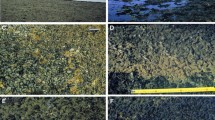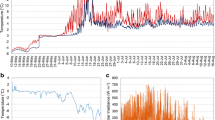Abstract
The formation of cyanobacterial mats (originally induced by incubation of sediment cores in which metazoans and most other eukaryotes had been removed) was followed over approximately 2.6 years. The thickness of the mats increased at a rate of 2–3 mm per year because of accumulation of empty cyanobacterial sheaths and as a result of carbonate deposition; the fraction of living biomass remained relatively constant over at least 2 years, but there was a slow accumulation of nonliving organic C (≈ 1 mmol yr−1). Biota composition (dominated by five types of filamentous cyanobacteria, unicellular cyanobacteria, diatoms, anoxygenic phototrophs, and heterotrophic bacteria) and vertical zonation patterns in the upper 2–3 mm of the mats were also almost constant over time. Using transmission electron microscopy and stereological analysis it was possible to quantify the vertical distribution of major groups of organisms.
Similar content being viewed by others
Author information
Authors and Affiliations
Additional information
Received: 20 December 1999; Accepted: 10 June 2000; Online Publication: 28 August 2000
Rights and permissions
About this article
Cite this article
Fenchel, T., Kühl, M. Artificial Cyanobacterial Mats: Growth, Structure, and Vertical Zonation Patterns. Microb Ecol 40, 85–93 (2000). https://doi.org/10.1007/s002480000062
Issue Date:
DOI: https://doi.org/10.1007/s002480000062




